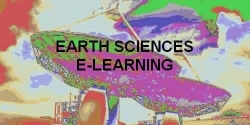Tsunamis
Tsunamis
back to Contents of entire course...
What does "tsunami" mean?
Physical Characteristics of
Tsunamis
How do earthquakes generate
tsunamis?
4 Stages in Tsunami Formation
How do tsunamis differ from
other water waves?
How do landslides,
volcanic eruptions, and cosmic collisions generate tsunamis?
How Tsunamis are Generated
Mitigation of Risks and Hazards
Tsunami Safety Rules
Tsunami movie clips
adapted to HTML from the course notes of Prof. Stephen A. Nelson Tulane
University What is a Tsunami?
What does "tsunami" mean?
Tsunami is a Japanese word with the English translation, "harbor wave." Represented by two characters, the top character, "tsu," means harbor, while the bottom character, "nami," means "wave." In the past, tsunamis were sometimes referred to as "tidal waves" by the general public, and as "seismic sea waves" by the scientific community.
The term "tidal wave" is a misnomer; although a tsunami's impact upon a coastline is dependent upon the tidal level at the time a tsunami strikes, tsunamis are unrelated to the tides. Tides result from the imbalanced, extraterrestrial, gravitational influences of the moon, sun, and planets.
The term "seismic sea wave" is also misleading. "Seismic" implies an earthquake-related generation mechanism, but a tsunami can also be caused by a nonseismic event, such as a landslide or meteorite impact.
A tsunami is a very long-wavelength wave of water that is generated by sudden displacement of the seafloor or disruption of any body of standing water.
Tsunamis are sometimes called "seismic sea waves", although, as we will see, they can be generated by other mechanisms than earthquakes.
Tsunamis have also been called "tidal waves", but this term should not be used because they are not in any way related to the tides of the Earth. Because tsunamis occur suddenly, often without warning, they are extremely dangerous to coastal communities.
Physical Characteristics of Tsunamis
All types of waves, including tsunamis, have a wavelength, a wave height, an amplitude, a frequency or period, and a velocity.
Wavelength is defined as the distance between two identical points on a wave (i.e. between wave crests or wave troughs).
Normal ocean waves have wavelengths of about 100 meters.
Tsunamis have much longer wavelengths, usually measured in kilometers and up to 200 kilometers
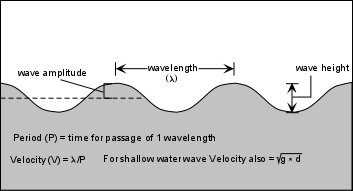
- Wave height refers to the distance between the trough of the wave and the crest or peak of the wave.
- Wave amplitude- refers to the height of the wave above the still water line, usually this is equal to 1/2 the wave height. Tsunamis can have variable wave height and amplitude that depends on water depth as we shall see in a moment
- Wave frequency or period - is the amount of time it takes for one full wavelength to pass a stationary point.
- Wave velocity is the speed of the wave. Velocities of normal ocean waves are about 90 km/hr while tsunamis have velocities up to 950 km/hr (about as fast as jet airplanes), and thus move much more rapidly across ocean basins. The velocity of any wave is equal to the wavelength divided by the wave period.
V = l/P
Tsunamis are characterized as shallow-water waves. These are different from the waves most of us have observed on a the beach, which are caused by the wind blowing across the ocean's surface. Wind-generated waves usually have period (time between two successive waves) of five to twenty seconds and a wavelength of 100 to 200 meters.
A tsunami can have a period in the range of ten minutes to two hours and wavelengths greater than 500 km.
A wave is characterized as a shallow-water wave when the ratio of the water depth and wavelength is very small. The velocity of a shallow-water wave is also equal to the square root of the product of the acceleration of gravity,
g
(980cm/sec/sec) and the depth of the water,d
V=Ög * d
The rate at which a wave loses its energy is inversely related to its wavelength. Since a tsunami has a very large wavelength, it will lose little energy as it propagates. Thus, in very deep water, a tsunami will travel at high speeds with little loss of energy. For example, when the ocean is 6100 m deep, a tsunami will travel about 890 km/hr, and thus can travel across the Pacific Ocean in less than one day.
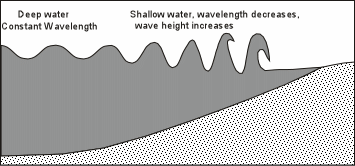
As a tsunami leaves the deep water of the open sea and arrives at the shallow waters near the coast, it undergoes a transformation. Since the velocity of the tsunami is also related to the water depth, as the depth of the water decreases, the velocity of the tsunami decreases. The change of total energy of the tsunami, however, remains constant
Furthermore, the period of the wave remains the same, and thus more water is forced between the wave crests causing the height of the wave to increase.
Because of this "shoaling" effect, a tsunami that was imperceptible in deep water may grow to have wave heights of several meters or more.
If the trough of the tsunami wave reaches the coast first, this causes a phenomenon called drawdown, where it appears that sea level has dropped considerably.
Drawdown is followed immediately by the crest of the wave which can catch people observing the drawdown off guard. When the crest of the wave hits, sea level rises (called run-up ).
Run-up is usually expressed in meters above normal high tide.
Run-ups from the same tsunami can be variable because of the influence of the shapes of coastlines. One coastal area may see no damaging wave activity while in another area destructive waves can be large and violent. The flooding of an area can extend inland by 300 m or more, covering large areas of land with water and debris. Flooding tsunami waves tend to carry loose objects and people out to sea when they retreat.
Tsunamis may reach a maximum vertical height onshore above sea level, called a run-up height, of 30 meters. A notable exception is the landslide generated tsunami in Lituya Bay, Alaska in 1958 which produced a 60 meter high wave
Because the wavelengths and velocities of tsunamis are so large, the period of such waves is also large, and larger than normal ocean waves. Thus it may take several hours for successive crests to reach the shore. (For a tsunami with a wavelength of 200 km traveling at 750 km/hr, the wave period is about 16 minutes).
Thus people are not safe after the passage of the first large wave, but must wait several hours for all waves to pass. The first wave may not be the largest in the series of waves. For example, in several different recent tsunamis the first, third, and fifth waves were the largest.
How do earthquakes generate tsunamis?
Tsunamis can be generated when the sea floor abruptly deforms and vertically displaces the overlying water. Tectonic earthquakes are a particular kind of earthquake that are associated with the earth's crustal deformation; when these earthquakes occur beneath the sea, the water above the deformed area is displaced from its equilibrium position. Waves are formed as the displaced water mass, which acts under the influence of gravity, attempts to regain its equilibrium. When large areas of the sea floor elevate or subside, a tsunami can be created.
Large vertical movements of the earth's crust can occur at plate boundaries. Plates interact along these boundaries called faults. Around the margins of the Pacific Ocean, for example, denser oceanic plates slip under continental plates in a process known as subduction. Subduction earthquakes are particularly effective in generating tsunamis.
4 Stages in Tsunami Formation

- 1--Initiation: Earthquakes are commonly associated with ground shaking that is a result of elastic waves traveling through the solid earth. However, near the source of submarine earthquakes, the seafloor is "permanently" uplifted and down-dropped, pushing the entire water column up and down. The potential energy that results from pushing water above mean sea level is then transferred to horizontal propagation of the tsunami wave (kinetic energy). For the case shown above, the earthquake rupture occurred at the base of the continental slope in relatively deep water. Situations can also arise where the earthquake rupture occurs beneath the continental shelf in much shallower water. Note: In the figure the waves are greatly exaggerated compared to water depth! In the open ocean, the waves are at most, several meters high spread over many tens to hundreds of kilometers in length
![[ Image of Tsunami Wave Split ]](image20.gif)
- 2--Split: Within several minutes of the earthquake, the initial tsunami (Panel 1) is split into a tsunami that travels out to the deep ocean (distant tsunami) and another tsunami that travels towards the nearby coast (local tsunami). The height above mean sea level of the two oppositely traveling tsunamis is approximately half that of the original tsunami (Panel 1). (This is somewhat modified in three dimensions, but the same idea holds.) The speed at which both tsunamis travel varies as the square root of the water depth. Therefore the deep-ocean tsunami travels faster than the local tsunami near shore.
![[ Image of Tsunami Amplification ]](image23.gif)
- 3--Amplification: Several things happen as the local tsunami travels over the continental slope. Most obvious is that the amplitude increases. In addition, the wavelength decreases. This results in steepening of the leading wave--an important control of wave runup at the coast (next panel). Note also that the deep ocean tsunami has traveled much farther than the local tsunami because of the higher propagation speed. As the deep ocean tsunami approaches a distant shore, amplification and shortening of the wave will occur, just as with the local tsunami shown above.
![[ Image of Tsunami Runup ]](image22.gif)
- 4--Runup: As the tsunami wave travels from the deep-water, continental slope region to the near-shore region, tsunami runup occurs. Runup is a measurement of the height of the water onshore observed above a reference sea level. Contrary to many artistic images of tsunamis, most tsunamis do not result in giant breaking waves (like normal surf waves at the beach that curl over as they approach shore). Rather, they come in much like very strong and very fast tides (i.e., a rapid, local rise in sea level). Much of the damage inflicted by tsunamis is caused by strong currents and floating debris. The small number of tsunamis that do break often form vertical walls of turbulent water called bores. Tsunamis will often travel much farther inland than normal waves. Do tsunamis stop once on land? After runup, part of the tsunami energy is reflected back to the open ocean. In addition, a tsunami can generate a particular type of wave called edge waves that travel back-and forth, parallel to shore. These effects result in many arrivals of the tsunami at a particular point on the coast rather than a single wave suggested by Panel 3. Because of the complicated behavior of tsunami waves near the coast, the first runup of a tsunami is often not the largest, emphasizing the importance of not returning to a beach several hours after a tsunami hits.
How do tsunamis differ from other water waves?


Tsunamis are unlike wind-generated waves, which many of us may have observed on a local lake or at a coastal beach, in that they are characterized as shallow-water waves, with long periods and wave lengths. The wind-generated swell one sees at a California beach, for example, spawned by a storm out in the Pacific and rhythmically rolling in, one wave after another, might have a period of about 10 seconds and a wave length of 150 m. A tsunami, on the other hand, can have a wavelength in excess of 100 km and period on the order of one hour.
As a result of their long wave lengths, tsunamis behave as shallow-water waves. A wave becomes a shallow-water wave when the ratio between the water depth and its wave length gets very small. Shallow-water waves move at a speed that is equal to the square root of the product of the acceleration of gravity (9.8 m/s/s) and the water depth - let's see what this implies: In the Pacific Ocean, where the typical water depth is about 4000 m, a tsunami travels at about 200 m/s, or over 700 km/hr. Because the rate at which a wave loses its energy is inversely related to its wave length, tsunamis not only propagate at high speeds, they can also travel great, transoceanic distances with limited energy losses.
How do landslides, volcanic eruptions, and cosmic collisions generate
tsunamis?
A tsunami can be generated by any disturbance that displaces a large water mass from its equilibrium position. In the case of earthquake-generated tsunamis, the water column is disturbed by the uplift or subsidence of the sea floor. Submarine landslides, which often accompany large earthquakes, as well as collapses of volcanic edifices, can also disturb the overlying water column as sediment and rock slump downslope and are redistributed across the sea floor. Similarly, a violent submarine volcanic eruption can create an impulsive force that uplifts the water column and generates a tsunami. Conversely, supermarine landslides and cosmic-body impacts disturb the water from above, as momentum from falling debris is transferred to the water into which the debris falls. Generally speaking, tsunamis generated from these mechanisms, unlike the Pacific-wide tsunamis caused by some earthquakes, dissipate quickly and rarely affect coastlines distant from the source area.
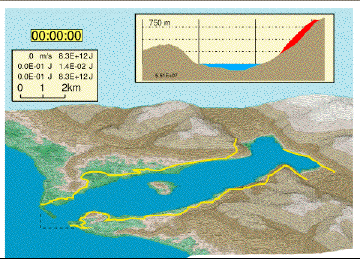
This image shows Lituya Bay, Alaska, after a huge, landslide-generated tsunami occurred on July 9, 1958. The earthquake-induced rockslide, shown in upper right-hand corner of this image, generated a 525 m splash-up immediately across the bay, and razed trees along the bay and across LaChausse Spit before leaving the bay and dissipating in the open waters of the Gulf of Alaska
How Tsunamis are Generated
There is an average of two destructive tsunamis per year in the Pacific basin. Pacific wide tsunamis are a rare phenomenon, occurring every 10 - 12 years on the average.
Most of these tsunamis are generated by earthquakes that cause displacement of the seafloor, but, as we shall see, tsunamis can be generated by volcanic eruptions, landslides, underwater explosions, and meteorite impacts.
Earthquakes
Earthquakes cause tsunamis by causing a disturbance of the seafloor. Thus, earthquakes that occur along coastlines or anywhere beneath the oceans can generate tsunamis.
The size of the tsunami is usually related to the size of the earthquake, with larger tsunamis generated by larger earthquakes. But the sense of displacement is also important. Tsunamis are generally only formed when an earthquake causes vertical displacement of the seafloor.
The 1906 earthquake near San Francisco California had a Richter Magnitude of about 7.1, yet no tsunami was generated because the motion on the fault was strike-slip motion with no vertical displacement.
Thus tsunamis only occur if the fault generating the earthquake has normal or reverse displacement.
Because of this, most tsunamis are generated by earthquakes that occur along the subduction boundaries of plates, along the oceanic trenches.
Since the Pacific Ocean is surrounded by plate boundaries of this type, tsunamis are frequently generated by earthquakes around the margins of the Pacific Ocean.
Examples of Tsunamis generated by Earthquakes
-
April 1, 1946 - A magnitude 7.3 earthquake occurred near Unimak Island
in the Aleutian Islands west of Alaska, near the Alaska Trench.
Sediment accumulating in the trench slumped into the trench and generated a tsunami. A lighthouse at Scotch Gap built of steel reinforced concrete was located on shore at an elevation of 14 m above mean low water.
The first wave of the tsunami hit the Scotch Gap area 20 minutes after the earthquake, had a run-up 30 m and completely destroyed the lighthouse.
4.5 hours later the same tsunami reached the Hawaiian Islands after traveling at an average speed of 659 km/hr.
As it approached the city of Hilo on the Big Island, it slowed to about 47 km/hr (note that even the fastest human cannot run faster than about 35 km/hr) and had a run-up of 18 m above normal high tide. It killed 159 people (90 in Hilo) and caused $25 million in property damage.
Hilo Tsunami Simulation(.mpg)
-
May 22, 1960 - A magnitude 8.6 earthquake occurred along the subduction
zone off South America.
Because the population of Chile (movie clip) is familiar with earthquakes and potential tsunamis, most people along the coast moved to higher ground.
15 minutes after the earthquake, a tsunami with a run-up of 4.5 m hit the coast.
The first wave then retreated, dragging broken houses and boats back into the ocean.
Many people saw this smooth retreat of the sea as a sign they could ride their boats out to sea and recover some of the property swept away by the first wave.
But, about 1 hour later, the second wave traveling at a velocity of 166 km/hr crashed in with a run-up of 8 m.
This wave crushed boats along the coast and destroyed coastal buildings. This was followed by a third wave traveling at only 83 km/hr that crashed in later with a run-up of 11 m, destroying all that was left of coastal villages.
The resulting causalities listed 909 dead with 834 missing.
In Hawaii, a tsunami warning system was in place and the tsunami was expected to arrive at 9:57 AM.
It hit at 9:58 AM and 61 people died, mostly sightseers that wanted to watch the wave roll in at close range (obviously they were too close).
The tsunami continued across the Pacific Ocean, eventually reaching Japan where it killed an additional 185 people.
Chile Tsunami Simulation(.mpg)
March 27, 1964 - The Good Friday Earthquake in Alaska had a magnitude of 8.5 on the Richter Scale.
This earthquake also occurred along the subduction zone, and as we saw in our study of earthquakes, caused deformation of the crust where huge blocks where dropped down as much as 2.3
m.
Because the coastline of Alaska is sparsely populated, only 122 people died from the tsunami in Alaska.
With a tsunami warning system in place in Crescent City, California, all the townspeople moved to higher ground.
After watching four successive waves destroy their town, many people returned to the low lying areas to assess the damage to their property.
The fifth wave had the largest run-up of 6.3 m and killed 12 people.
September 2, 1992 - A magnitude 7 earthquake off the coast of Nicaragua in Central America occurred along the subduction zone below the Middle America Trench. The earthquake was barely felt by the residents of Nicaragua and was somewhat unusual.
A 100 km-long segment of the oceanic lithosphere moved 1 m further below the over riding plate over a period of two minutes.
Much energy was released but the ground did not shake very much.
Seawater apparently absorbed some of the energy and sent a tsunami onto the coast.
Residents had little warning, 150 people died and 13,000 people were left homeless.
Volcanic Eruptions
Volcanoes that occur along coastal zones, like in Japan and island arcs throughout the world, can cause several effects that might generate a tsunami.
Explosive eruptions can rapidly emplace pyroclastic flows into the water, landslides and debris avalanches produced by eruptions can rapidly move into water, and
collapse of volcanoes to form calderas can suddenly displace the water.
The eruption of Krakatau in the Straights of Sunda, between Java and Sumatra, in 1883 generated at least three tsunamis that killed 36,417 people.
It is still uncertain exactly what caused the tsunamis, but it is known that several events that occurred during the eruption could have caused such tsunamis.
-
A large Plinian eruption column blasted pumice and ash up to 40 km into
the atmosphere.
This Plinian eruption column likely collapsed several times to produce pyroclastic flows, any of which could have generated a tsunami. A loud explosive blast was heard as far away as Australia.
This blast was likely caused by a phreatic explosion that occurred as a result of seawater coming in contact with the magma.
The explosion could have generated at least one of the tsunamis.
At some point during the eruption a caldera formed by collapse of the volcanic island.
Areas that were once more than 300 m above sea level were found 300 m below sea level after the eruption.
The sudden collapse of the volcano to form this caldera could have caused one or more tsunamis.
Earthquakes were felt throughout the eruption.
Any one of these submarine earthquakes could have caused a tsunami.
A large block of coral weighing about 600 tons was ripped off the
seafloor and deposited 100 m inland.
One ship was carried 2.5 km inland and was left 24 meters above sea level, with all of its crew swept into the ocean. We have previously discussed the likelihood that tsunamis accompanied the eruptions of Mount Pelée, Martinique in 1902 and Vesuvius in 79 A.D.
Landslides
Landslides moving into oceans, bays, or lakes can also generate tsunamis.
Most such landslides are generated by earthquakes or volcanic eruptions.
As previously mentioned, a large landslide or debris avalanche fell into Lituya Bay, Alaska in 1958 causing a wave with a run-up of about 60 m as measured by a zone completely stripped of vegetation.
Underwater Explosions
Nuclear testing by the United States in the Marshall Islands in the 1940s and 1950s generated tsunamis.
Meteorite Impacts
While no historic examples of meteorite impacts are known to have produced a tsunami, the apparent impact of a meteorite at the end of the Cretaceous Period, about 65 million years ago near the tip of what is now the Yucatan Peninsula of Mexico, produced tsunamis that left deposits all along the Gulf coast of Mexico and the United States.
Mitigation of Risks and Hazards
The main damage from tsunamis comes from the destructive nature of the waves themselves. Secondary effects include the debris acting as projectiles which then run into other objects, erosion that can undermine the foundations of structures built along coastlines, and fires that result from disruption of gas and electrical lines.
Tertiary effects include loss of crops and water and electrical systems which can lead to famine and disease.
Within the last century there have been 94 destructive tsunamis which have resulted in 51,000 deaths.
Despite the fact that tsunami warning systems have been in place since 1950, deaths still result from tsunamis, especially when the source of the earthquake is so close to a coast that there is little time for a warning, or when people do not heed the warning or follow instructions associated with the warning.
Prediction and Early Warning
For areas located at great distances from earthquakes that could potentially generate a tsunami there is usually plenty of time for warnings to be sent and coastal areas evacuated, even though tsunamis travel at high velocities across the oceans.
Hawaii is good example of an area located far from most of the sources of tsunamis, where early warning is possible and has saved lives.
For earthquakes occurring anywhere on the subduction margins of the Pacific Ocean there is a minimum of 4 hours of warning before a tsunami would strike any of the Hawaiian Islands.
The National Oceanic and Atmospheric Administration (NOAA)
has set up a Pacific warning system for areas in the Pacific Ocean, called the
Pacific Tsunami Warning Center.
It consists of an international network of seismographic stations, and tidal stations around the Pacific basin that can all send information via satellite to the Center located in Hawaii.
When an earthquake occurs somewhere in the region, the Center immediately begins to analyze the data looking for signs that the earthquake could have generated a tsunami.
The tidal stations are also monitored, and if a tsunami is detected, a warning is sent out to all areas on the Pacific coast.
It takes at least 1 hour to assimilate all of the information and issue a warning.
Thus for an average velocity of a tsunami of 750 km/hr, the regional system can provide a warning sufficient for adequate evacuation of coastal areas within 750 km of the earthquake.
In order to be able to issue warnings about tsunamis generated within 100 to 750 km of an earthquake, several regional warning centers have been set up in areas prone to tsunami generating earthquakes.
These include centers in Japan, Kamchatka, Alaska, Hawaii, French Polynesia, and Chile.
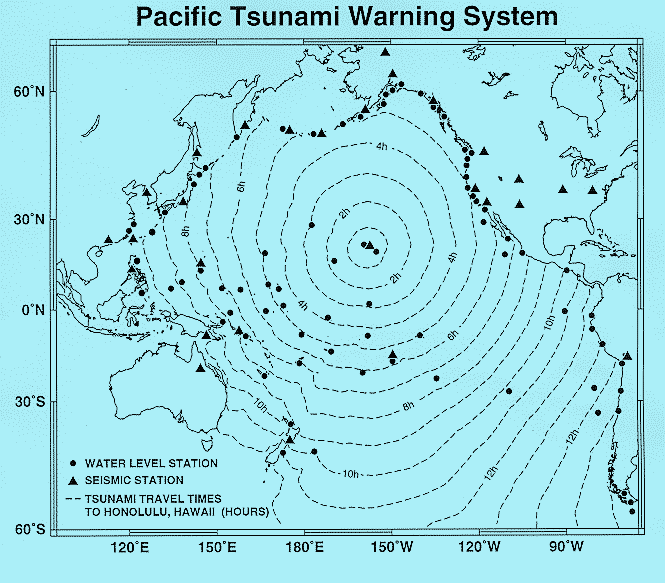
These systems have been very successful at saving lives.
For example, before the Japanese warning system was established, 14 tsunamis killed over 6000 people in Japan.
Since the establishment of the warning system 20 tsunamis have killed 215 people in Japan.
Like all warning systems, the effectiveness of tsunami early warning depends strongly on local authority's ability to determine that their is a danger, their ability to disseminate the information to those potentially affected, and on the education of the public to heed the warnings and remove themselves from the area.
Tsunami Safety Rules
In case you are ever in an area where there is a threat of tsunami, I have downloaded the following tsunami safety rules from the
West Coast & Alaska Tsunami Warning Center Home Page:
http://www.alaska.net/~atwc/
- A strong earthquake felt in a low-lying coastal area is a natural warning of possible, immediate danger. Keep calm and quickly move to higher ground away from the coast. All large earthquakes do not cause tsunamis, but many do. If the quake is located near or directly under the ocean, the probability of a tsunami increases. When you hear that an earthquake has occurred in the ocean or coastline regions, prepare for a tsunami emergency.
- Tsunamis can occur at any time, day or night. They can travel up rivers and streams that lead to the ocean.
- A tsunami is not a single wave, but a series of waves. Stay out of
danger until an "ALL CLEAR" is issued by a competent authority.
Approaching tsunamis are sometimes heralded by noticeable rise or fall of coastal waters. This is nature's tsunami warning and should be heeded. - A small tsunami at one beach can be a giant a few miles away. Do not let modest size of one make you lose respect for all.
- Sooner or later, tsunamis visit every coastline in the Pacific. All tsunamis - like hurricanes - are potentially dangerous even though they may not damage every coastline they strike.
- Never go down to the beach to watch for a tsunami! WHEN YOU CAN SEE THE WAVE YOU ARE TOO CLOSE TO ESCAPE. Tsunamis can move faster than a person can run!
- During a tsunami emergency, your local emergency management office, police, fire and other emergency organizations will try to save your life. Give them your fullest cooperation.
- Homes and other buildings located in low lying coastal areas are not
safe. Do NOT stay in such buildings if there is a tsunami warning.
The upper floors of high, multi-story, reinforced concrete hotels can provide refuge if there is no time to quickly move inland or to higher ground. - If you are on a boat or ship and there is time, move your vessel to deeper water (at least 100 fathoms). If it is the case that there is concurrent severe weather, it may safer to leave the boat at the pier and physically move to higher ground.
- Damaging wave activity and unpredictable currents can effect harbor conditions for a period of time after the tsunami's initial impact. Be sure conditions are safe before you return your boat or ship to the harbor.
- Stay tuned to your local radio, marine radio, NOAA Weather Radio, or television stations during a tsunami emergency - bulletins issued through your local emergency management office and NationalWeather Service offices can save your life
Tsunami movie clips (clips open in a new window)
Hokkaido Tsunami Simulation(.mpg)
Chcxulub Asteroid Tsunami Simulation(.mov)
Humboldt Tsunami(animated.gif)
La Palma(animated.gif)

